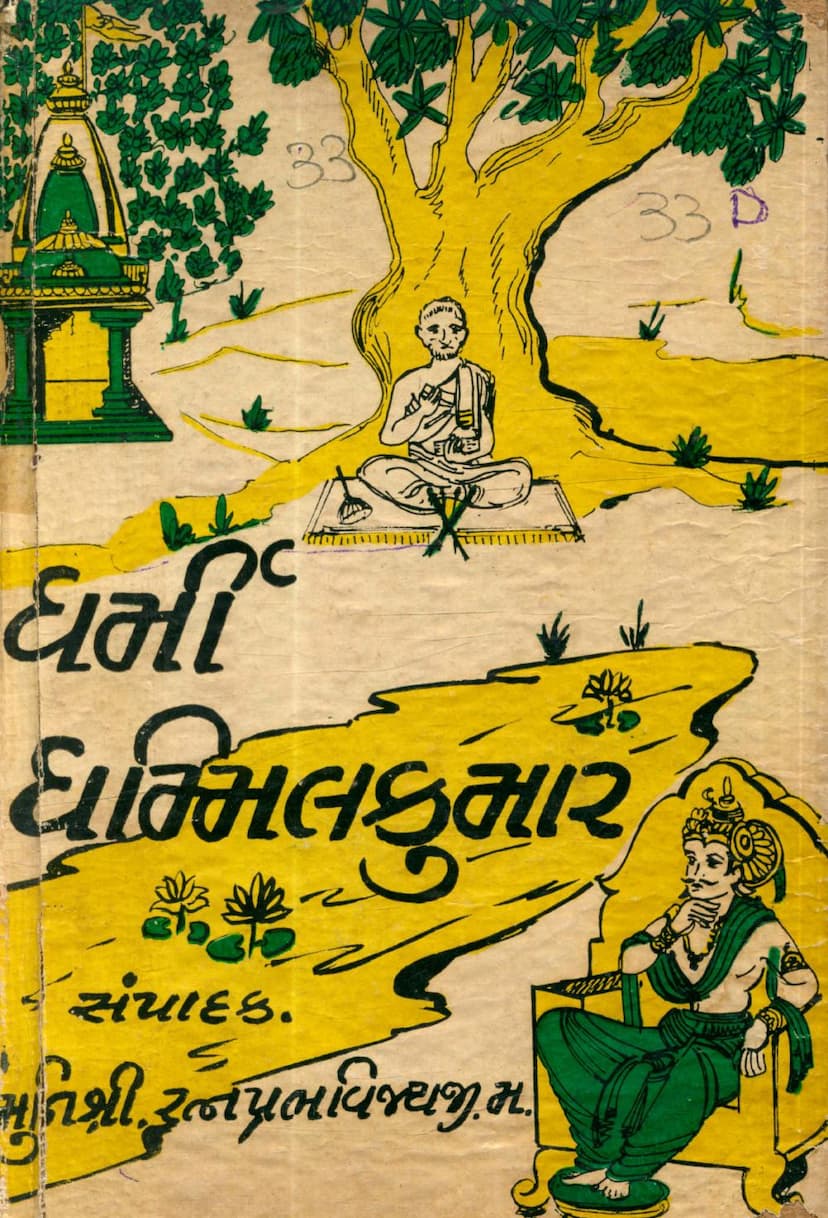Dharmi Dhammil Kumar
Added to library: September 1, 2025

Summary
Here's a comprehensive summary of the Jain text "Dharmi Dhammil Kumar" by Ratnaprabhvijay, based on the provided pages:
Book Title: Dharmi Dhammil Kumar (or Dharmil Kumar) Author: Ratnaprabhvijay Publisher: Shri Dharnath P. H. Jainnagar Shvetambar Murtipujak Jain Sangh, Paldi, Ahmedabad-7 Catalog Link: https://jainqq.org/explore/022894/1
Overall Summary:
"Dharmi Dhammil Kumar" is a Jain narrative that emphasizes the importance of Daya (compassion) and Sheel (virtue/chastity) as core principles for spiritual progress and overall well-being. The book, presented as a collection of stories and teachings attributed to Muni Ratnaprabhvijay, guides readers on the path to self-improvement and spiritual liberation. It highlights the consequences of neglecting dharma and succumbing to worldly temptations, while showcasing the rewards of virtuous living.
Key Themes and Stories:
The book is structured into several chapters, each seemingly presenting a distinct story or lesson:
- Shresth Abhaydaan (The Best Assurance of Fearlessness/Protection): This chapter likely introduces the concept of courage derived from righteous conduct and possibly illustrates the virtue of protecting those in danger, a theme often linked to compassion.
- Surendradatt ane Rajputra (Surendradatt and the Prince): This narrative seems to focus on the early life and education of a noble character, Surendradatt, and possibly a prince, highlighting the importance of learning and character development from a young age.
- Bhavi Dampati ni Samasya (The Problem of the Future Couple): This chapter likely delves into challenges faced by a destined couple, perhaps related to societal pressures, karma, or their own character flaws, and how they navigate these issues.
- Kulatasurakshaa (Protection of Family Honor/Lineage): This section appears to discuss the importance of maintaining familial reputation and perhaps the consequences of actions that bring shame upon one's lineage.
- Dharm Bhuleli Subhadra ne Shiksha (The Lesson for Subhadra Who Forgot Dharma): This story likely centers on a character named Subhadra who strays from righteous path and the subsequent lessons she learns, emphasizing the importance of remembering one's spiritual duties.
- Charitra Nayak ne Janma (The Birth of the Protagonist): This chapter introduces the birth of the central character, Dhammil Kumar, likely setting the stage for his life's journey and the lessons he will embody.
- Yogi ne Bhogi Banavyo (The Ascetic Made into an Enjoyer): This narrative might explore a character's transformation from a spiritual ascetic to someone entangled in worldly pleasures, highlighting the dangers of succumbing to desires.
- "Hathna Karya Haye Vagya" (What the Hands Did, The Heart Experienced): This is a Gujarati idiom signifying that one must face the consequences of their actions. This chapter likely illustrates how characters experience the karmic repercussions of their deeds.
- Aatmakarak-Gunvarmya (Self-Acting/Self-Creator - Guṇavarmā): This chapter introduces the story of Guṇavarmā, a character whose name implies virtue. The narrative might focus on his actions and how he shapes his own destiny through them.
- Agaladatt–Dhammil (Agaladatt – Dhammil): This chapter likely connects the character Agaladatt with Dhammil, possibly indicating a shared journey or a relationship between them in their respective stories.
- Dhammil Bhog-Vilas ma (Dhammil in Enjoyment and Luxury): This chapter portrays Dhammil's immersion in worldly pleasures and indulgences, likely serving as a cautionary tale about the allure and eventual emptiness of sensual gratification.
- Shil nu Tej (The Radiance of Chastity/Virtue): This chapter strongly emphasizes the power and beauty of chastity and virtue, showcasing its protective and illuminating qualities in a person's life.
- Dhammil ne Vipul Sansar (Dhammil's Extensive Worldly Life): This likely describes Dhammil's vast engagement with the material world and its transient pleasures.
- Sanyam na Panthe Charitra Nayak (The Protagonist on the Path of Restraint): This chapter marks a significant turn, with the protagonist embarking on the path of self-discipline and spiritual practice, indicating a journey towards liberation.
Underlying Principles and Moral Teachings:
- Daya (Compassion) is Paramount: The text repeatedly stresses that Daya is the essence of Dharma. Without compassion, any religious practice is meaningless.
- Sheel (Chastity/Virtue) is Essential: Sheel is depicted as a source of inner strength, protection, and spiritual radiance, capable of overcoming even formidable challenges.
- Karmic Consequences ("Hathna Karya Haye Vagya"): The book emphasizes that one must face the outcomes of their actions, both good and bad.
- The Perils of Indulgence: Dhammil's journey through enjoyment and luxury serves as a warning against being consumed by worldly desires, which can lead to spiritual downfall.
- The Importance of Restraint and Self-Discipline: The shift towards the "path of restraint" (Sanyam) signifies the necessity of controlling one's senses and desires for spiritual growth.
- Discernment and Wisdom: Characters like Subhadra and the protagonist's mother (Subhadra, wife of Sagardatt) demonstrate wisdom in their choices, while others like the prince or the gambler face negative consequences due to poor decisions.
- The Value of True Companionship and Virtue: The narrative likely contrasts superficial relationships with genuine bonds based on virtue and character.
- The Fleeting Nature of Worldly Possessions: The book implicitly suggests that material wealth and sensual pleasures are temporary, while spiritual virtues endure.
- The Role of Divine Grace and Karma: While personal effort is crucial, the stories may also touch upon the influence of destiny (karma) and divine intervention or blessings.
In Essence:
"Dharmi Dhammil Kumar" appears to be a didactic work aiming to educate readers on Jain principles through engaging narratives. It encourages readers to cultivate compassion, practice virtue, and exercise restraint in their pursuit of spiritual well-being, warning against the pitfalls of worldly attachment and emphasizing the long-term rewards of a dharmic life. The story of Dhammil, in particular, likely illustrates a transformative journey from indulgence to renunciation and spiritual realization.